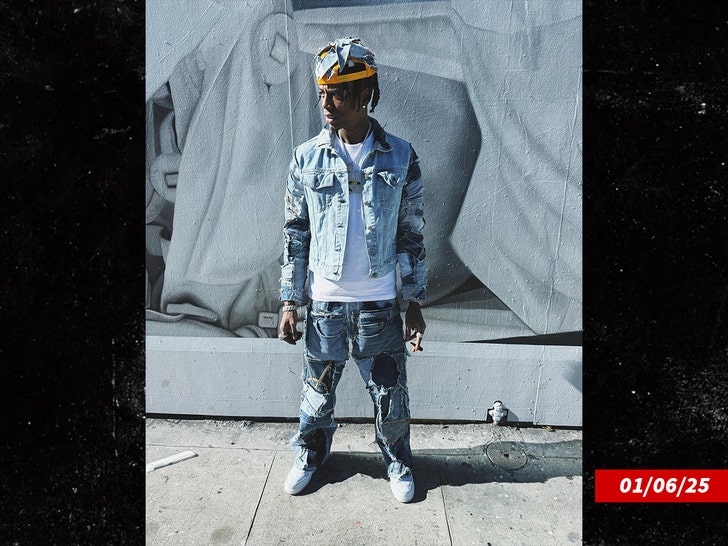Lifestyle
Celebs N' Cocktails — Bikini Mixes for National Cocktail Day!

Celebs N’ Cocktails …
Bikini Mixes For
National Cocktail Day!
Published
Who’s in need of cooling off with some celebs n’ cocktails? In celebration of National Cocktail Day, we’re serving up fresh bikini-brewed mixed drinks just for you!
Sexy stars like Nina Dobrev and Amanda Holden sipped cold ones while posing poolside, and Charly Jordan and Juliette Porter flaunted their summer-ready bods — modeling their two-pieces and enjoying fresh bevs!
And not to worry if booze ain’t your thing … There’s plenty of mocktails to go around too!
Keep those glasses half full and check out our gallery of Sexy Cocktail Stars …
Cheers!

Lifestyle
No Naked Dressing at Cannes Film Festival? How Will Stars Make News?

The Cannes Film Festival is getting more covered-up — and just in time for the opening ceremony honoring the octogenarian Robert De Niro. Bella Hadid, newly blonde, is already in town, and stars expected include Halle Berry, Scarlett Johansson and Emma Stone. But anyone expecting one of the most reliable moves on the red carpet might be disappointed. The new dress code for gala screenings includes the admonition, “for decency reasons, nudity is prohibited on the red carpet, as well as in any other area of the festival.”
Cue a crisis in the fashion-film industrial complex.
After all, nowhere has the naked dress been more of a presence than at Cannes, where the combination of Mediterranean, sun and a certain Gallic disdain for prudishness (or at least perceived disdain for prudishness) have conspired to create its own tradition of sartorial liberation.
And “nudity,” when it comes to celebrity dressing, is a relative term. The idea that it may no longer be a shortcut to the spotlight is even more shocking than the clothing it may be proscribing.
“Naked dressing,” or that mode of dress in which large swaths of the normally private body are aired for public viewing, has been a tent pole of the publicity machine since long before Marilyn Monroe cooed “Happy birthday, Mr. President” into a microphone in a flesh-colored sheath so tight it left little to the imagination.
In recent years it has become practically a category unto itself, especially at events like the Met Gala. That’s where Beyoncé played Venus on the half shell in 2015 in sheer Givenchy with strategically placed floral embroidery. Where, in 2024, Rita Ora wore a nude Marni bodysuit covered in what looked like strings, and Kylie Minogue modeled a Diesel dress with a naked torso superimposed on her actual torso. It has been framed as a post-Covid libidinal celebration and a post-#MeToo reclamation of the body. Either way, it is pretty much always a talking point.
All the way back in 1985, Ilona Staller, or La Cicciolina, the porn star, politician and former wife of Jeff Koons, walked the Cannes red carpet in a white satin … well, what would you call it? An evening version of Rudi Gernreich’s monokini, with breast-baring straps and a long white satin skirt. Madonna dropped her opera cape to reveal her Jean Paul Gaultier bullet bra and undies on the carpet in 1991, and in 2002 Cameron Diaz wore a sheer beaded gown and panties, starting a peekaboo trend that is still going strong.
Indeed, the dress as scrim, a transparent piece of nothing draped over bare skin or lingerie to suggest clothing without actually covering much of anything, is perhaps the most popular current form of naked dressing. It is more omnipresent than, say, the skirt slit up to here and the top cut down to there that has also been modeled by many on the red carpet. It provides the illusion of clothes while also teasing what is underneath.
It’s unclear from the wording of the Cannes dress code if the new policy applies only to literal nudity or to clothing that exposes body parts that might reasonably be termed “indecent.” According to Agnès Leroy, the head of press for the festival, the new rules were established to codify certain practices that have been long in effect. The aim, she said, “is not to regulate attire per se, but to prohibit full nudity — meaning the absence of clothing — on the red carpet, in accordance with the institutional framework of the event and French law.” (Even if French law allows toplessness on some beaches, a reality that may add to the confusion around the Cannes rules.)
Still, that leaves the dictum somewhat open to interpretation, given the general absence of fabric in many evening looks. One person’s vulgarity can be another person’s celebration, and who is to say who gets to police whose body?
(This is reminiscent of the time Melania Trump addressed critics of her naked photo shoots in her memoir, situating them in an artistic tradition that includes John Collier’s “Lady Godiva” and Michelangelo’s “David,” and noting that “we should honor our bodies and embrace the timeless tradition of using art as a powerful means of self-expression.”)
Perhaps the new code is simply calculated to prevent the sort of attention-grabbing stunt that occurred at the Grammys in February, when Ye, the rapper formerly known as Kanye West, crashed the red carpet with his wife, Bianca Censori, only to have her take off her fur coat to reveal her fully naked body “covered” by an entirely transparent nylon slip that provided no coverage at all. That seemed to have taken the trend to its ultimate, disturbing extreme by breaking the last barrier in naked dressing: genitalia.
Even though Ye had not actually been invited to the event, he and his wife dominated the headlines the next day more than the actual award ceremony.
The fact that the Cannes dress code also prohibits “voluminous outfits, in particular those with a large train, that hinder the proper flow of traffic of guests and complicate seating in the theater” suggests that what the organizers were really forestalling was the appearance of dresses that act as their own sort of performance art, grabbing eyeballs and dominating conversations that might otherwise be focused on the films that are the nominal point of the festival.
If that was the aim, however, it has somewhat backfired. By officially banning nudity on the carpet, the Cannes organizers simply sparked a raft of pieces (like this one) discussing nudity on the carpet. Most of them focus less on the actual meaning of the term in all its thorny nuance than the opportunity to revisit notorious nude-adjacent moments past.
You could have seen that one coming.
Lifestyle
DDG Reacts to Halle Bailey TRO … As Soulja Boy Threatens to Beat Him Down

DDG
Not Stressing About Halle Bailey Restraining Order
… But Soulja Boy Wants His Head!!!
Published
Halle Bailey was granted a restraining order against DDG after filing a laundry list of abusive allegations on Monday … but let the rapper/streamer tell it, he doesn’t have a care in the world!!!
i’m chillin btw.. i have no worries 😉 streaming later on, no days off!
— DDG (@PontiacMadeDDG) May 14, 2025
@PontiacMadeDDG
On Tuesday, DDG said he was “chilling” and vowed to still hop on his daily Twitch channel amid “The Little Mermaid” actress’ emergency filing.

We broke the story … Halle accused DDG of physically abusing her by chipping her tooth on a steering wheel during an altercation, breaking her Ring camera and even breaking into her phone and accusing her of cheating.
According to the suit, DDG also sent Halle antagonizing texts on Mother’s Day after social media posts implied she had jetted off with their son Halo for an island vacation with R&B star Brent Faiyaz.
After the news spread, DDG got plenty of support from online contemporaries such as DJ Akademiks, Adin Ross, Deshae Frost, and even DDG’s admitted foe Myron Gaines — but not Soulja Boy!!!

The “Crank Dat” rapper inexplicably threatened to beat down DDG when he catches him out in public for allegedly harming Halle.

Soulja Boy’s comments left the internet confused … considering he was just ordered to pay $4 million in damages for sexual battery and assault of his former assistant!!!
Lifestyle
How Pandora Is Surviving Trump’s Trade War

Pandora, the world’s largest jewelry company, is based in Denmark and has nearly 500 stores in the United States, more than in any of its other key markets. But in some ways, its real home is Thailand, where the company has been making its products for nearly four decades.
Like many global corporations, Pandora has used a continent-crossing supply chain to sell its goods worldwide at a low cost. But last month, that supply chain became a grave weakness when President Trump said he would impose 36 percent tariffs on goods entering the United States from Thailand, alongside steep tariffs on dozens of other countries.
After Mr. Trump unveiled his “reciprocal” tariffs, Pandora’s shares were among the worst performing in Europe. A week later, Mr. Trump postponed those tariffs until early July, offering a reprieve.
But the threat looms, and Alexander Lacik, the chief executive of Pandora, is not expecting the uncertainty that is paralyzing businesses to end. Unless tariffs return to previous levels, the next year will be turbulent, he said in an interview. For now, he added, there is little to do but wait to see how investors, customers and competitors react.
“With the information at hand today, I would be crazy to make big strategic decisions,” Mr. Lacik said.
Alongside business leaders all over the world, Mr. Lacik is grappling with how to respond to Mr. Trump’s unpredictable policies, which have generated almost maddening uncertainty. The Trump administration has started to show a willingness to lower tariffs, but his first agreements, with Britain and China, have posed more questions than answers, and tariffs are still higher than they were a couple of months ago.
Although some aspects of the trade war have been suspended, Pandora and other multinationals are in limbo, waiting for more agreements to be completed.
Pandora, best known for its silver charm bracelets, has been making jewelry in Thailand since 1989. Across three factories, thousands of people handcraft the products. The company is building a fourth plant in Vietnam, but Mr. Trump has threatened tariffs of 46 percent on Vietnamese goods.
Last year, the company sold 113 million pieces of jewelry, about three items every second, making it the largest jewelry brand by volume, with stores in more than 100 countries. A third of its sales, 9.7 billion Danish kroner, or $1.4 billion, were generated in the United States, and Mr. Lacik said he had no intention of moving away from the company’s most profitable market.
But prices will rise, he said, and who will bear the brunt of that is unclear.
“The big question is, am I going to pass on everything to the U.S. consumer, or am I going to peanut butter it out and raise the whole Pandora pricing globally?” Mr. Lacik said.
But Pandora keeps several months’ worth of stock, giving him time to see how other jewelers change their pricing and then decide.
A few things can be done immediately, such as streamlining parts of the supply chain. The day after the reciprocal tariffs were announced, Pandora said it would change its distribution so that products sold in Canada and Latin America would no longer move through the company’s distribution hub in Baltimore, a process that would take six to nine months to complete.
Moving production into the United States is not being considered, in part because of higher labor costs. Pandora employs nearly 15,000 craftspeople in Thailand and expects to hire 7,000 more in Vietnam.
In an earnings report last week, the company estimated the cost of the trade war. If higher tariffs on Thai imports, 36 percent, and Chinese imports, 145 percent, go back into effect, they will cost Pandora 500 million Danish kroner, or $74 million, this year, and then 900 million Danish kroner, $135 million, annually after that.
But the jeweler is not panicking. In fact, the economic curveballs are starting to feel normal, Mr. Lacik said. “We are battle ready,” he added.
When he joined the company as the chief executive in 2019, Pandora was struggling. Its share price had dropped more than 70 percent from its peak three years earlier. Mr. Lacik instituted a “complete overhaul,” he said, with new branding and store designs, an emphasis on its “affordable luxury” label, and a showcase of its complete jewelry line, not just charms.
That prepared the company for the trials that hit the global economy next. First, the Covid-19 pandemic, when 15,000 store employees were sent home and some factory workers slept on cots to keep production going. Then a surge in inflation risked customers pulling back.
Mr. Lacik’s strategy appeared to be working. In January, Pandora’s share price reached a record high. Since then, however, it has dropped more than 20 percent.
The company has managed to shield itself from some of the trade turmoil. After Mr. Trump raised tariffs on China during his first term, Pandora stopped sourcing all of its showroom furniture and display materials for its 3,000 stores from China.
“We had some readiness,” Mr. Lacik said, so they were not “caught completely with our pants down.”
-

 Austin, TX4 days ago
Austin, TX4 days agoBest Austin Salads – 15 Food Places For Good Greens!
-

 Education1 week ago
Education1 week agoIn Alabama Commencement Speech, Trump Mixes In the Political
-

 Technology1 week ago
Technology1 week agoBe careful what you read about an Elden Ring movie
-

 Culture1 week ago
Culture1 week agoPulitzer Prizes 2025: A Guide to the Winning Books and Finalists
-

 Technology6 days ago
Technology6 days agoNetflix is removing Black Mirror: Bandersnatch
-

 Education1 week ago
Education1 week agoUniversity of Michigan President, Santa Ono, Set to Lead University of Florida
-

 World6 days ago
World6 days agoThe Take: Can India and Pakistan avoid a fourth war over Kashmir?
-

 News6 days ago
News6 days agoReincarnated by A.I., Arizona Man Forgives His Killer at Sentencing
















